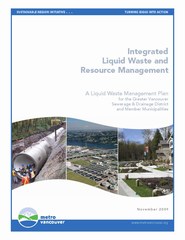Metro Vancouver Reference Panel informs Finance Committee deliberations on HOW to pay for two replacement sewage treatment plants
Note to Reader:
To download a PDF document version of the story below, click on Convening for Action in Metro Vancouver – Context for a conversation about shared responsibility and affordability
Integrated Liquid Waste & Resource Management in Metro Vancouver
In early 2008, Metro Vancouver initiated a consultation process to revisit the current Liquid Waste Management Plan (LWMP), approved by the Province  in 2002. The Board appointed the LWMP Reference Panel, a community advisory group, to provide expert knowledge and relevant experience in liquid waste/resource and rainwater management.
in 2002. The Board appointed the LWMP Reference Panel, a community advisory group, to provide expert knowledge and relevant experience in liquid waste/resource and rainwater management.
The plan development and consultation processes culminated in an Integrated Liquid Waste and Resource Management Plan. This was presented to the Metro Vancouver Board for adoption in November 2009. The critical issue before the Board was the timeline for replacement of the Iona Island and Lions Gate sewage treatment plants serving the Vancouver and North Shore sewerage areas, respectively.
Timeline for Replacement of Treatment Plants
The total capital cost for the two treatment plants is $1.4 billion. At its November 2009 meeting, The Metro Vancouver Board deferred making a decision on whether or not to complete both by 2020. Briefly, the timeline issue over treatment plant replacement is summarized as follows
- The 2002 Plan specified replacing Iona Island by 2020 and Lions Gate by 2030.
- In its July 2009 Final Report, the Reference Panel recommended to the Waste Management Committee that both plants be replaced by 2020.
- The November 2009 Plan reversed the order of plant replacement: Lions Gate by 2020; and Iona Island by 2030.
- The Waste Management Committee, however, recommended to the Board that both be replaced by 2020.
- The Board referred the timeline issue to the Finance Committee, and asked for input on the financing implications.
- The Finance Committee met in January 2010.
- The deliberations of the Finance Committee were informed by the Reference Panel.
The rationale for reversing the timeline in the November 2009 Plan was to align the Plan with the Canada-wide Strategy for the Management of Municipal Wastewater Effluent. The Strategy sets baseline wastewater management criteria, timelines and prioritization methodologies, and formalizes processes to assess environmental risk.
Financing Implications for Construction of Two Plants by 2020
To download a memorandum submitted to the Finance Committee by the Reference Panel, click on Financing Implications for Construction of Two Treatment Plants. Kim Stephens, Chair, met with the Finance Committee on January 29 to present the memorandum on behalf of the Reference Panel.
“The Reference Panel emphasis is on the challenge of HOW to pay for the two plants,” he stated. “In our view, implementation of the Canada-wide Strategy for the Management of Municipal Wastewater Effluent creates an obligation on the part of the senior governments to step up to the plate financially and fulfil their social and environmental responsibilities.”
Environmental and Legal Risks
“The Lions Gate and Iona Island treatment plants have each been in service for approximately 50 years. Both have exceeded their useful lives,” emphasized Kim Stephens.
“The Reference Panel believes that both are high risk facilities with attendant environmental and legal risks for Metro Vancouver. This conclusion is based on the existing treatment level combined with the nature of the respective receiving environments.”
Responsibility and Affordability
“The issue is HOW to finance the two plants at the same time so that both can be operational by 2020,” stated Kim Stephens. He then reviewed the following framework, point-by-point:
- The Canada-wide Strategy for the Management of Municipal Wastewater Effluent is imposing a national minimum standard of secondary treatment for liquid discharges.
- Natural assets will be damaged if replacement of Iona is delayed beyond 2020.
- There is only one taxpayer.
- Local government receives a mere 8% of total tax revenues.
- Senior governments have a shared responsibility to protect natural assets, including the critical habitat of species at risk, in particular those designated as ‘endangered’.
- When senior governments do not pay their fair share, this creates risks for Metro Vancouver and beyond.
- Pay now to save on future cleanup, restoration and construction costs.
“When you report back to the Board, you can acknowledge that there are risks associated with NOT upgrading both facilities by 2020; appeal to senior governments’ respective responsibilities and ultimate self-interest in doing what is right and cost-sharing; and most importantly, focus public attention on the need for balanced tax-sharing so that local government receives more than 8% of total tax revenues.”
Create an Environmental Legacy
He concluded with this quote from Strategic Commitment to the Environment by Municipal Corporations, published in 2003 by the National Research Council and the Federation of Canadian Communities as part of the InfraGuide Best Practice series:
“….For leading municipalities and private corporations, consideration for the  environment goes beyond compliance with regulations to pollution prevention and a precautionary approach. Leading municipalities now recognize that the cost of protecting the environment is dwarfed by the cost of not protecting it, over the long term. In addition, thoughtful municipal leaders recognize that the environmental legacy left for future citizens is the responsibility of current decision makers.”
environment goes beyond compliance with regulations to pollution prevention and a precautionary approach. Leading municipalities now recognize that the cost of protecting the environment is dwarfed by the cost of not protecting it, over the long term. In addition, thoughtful municipal leaders recognize that the environmental legacy left for future citizens is the responsibility of current decision makers.”
Outcome and Next Steps
The Reference Panel submission was followed by Metro Vancouver staff reports on the technical and financial aspects of the Integrated Liquid Waste & Resource Management Plan. Together, these sparked and informed a two hour discussion. To download a copy of the report by the Chief Financial Officer, click here.
Finance Committee Request for More Information
The Finance Committee concluded that it requires more information and one more round of discussion before it can make its recommendation(s) to the Board. Accordingly, the Finance Committee asked staff to prepare a report that will address a number of key items flowing from the Reference Panel submission, in particular how to strengthen the financing section to drive home the message that replacing the two treatment plants depends upon senior governments accepting their shared responsibilities.
 Mayor Malcolm Brodie, Finance Committee Chair, summed up the discussion by noting that the overall impact of constructing both treatment plants by 2020 is comparatively small. “The incremental difference in the annual financing cost of one versus two plants is not that much. The biggest hit is the first one.”
Mayor Malcolm Brodie, Finance Committee Chair, summed up the discussion by noting that the overall impact of constructing both treatment plants by 2020 is comparatively small. “The incremental difference in the annual financing cost of one versus two plants is not that much. The biggest hit is the first one.”
Plan Adoption in April?
“All in all, I believe the Finance Committee made the right decision in asking for more information. I was impressed by the high level of discussion. They are grasping the nuances of the timeline issue,” observed Kim Stephens afterwards. “As one Metro Vancouver staffer commented to me, the Reference Panel certainly sparked an informed discussion.”
“The Reference Panel understands that the Finance Committee will meet again in March; and that it will be April when the Board receives the Finance Committee recommendation and makes its decision to adopt the plan. After that, the plan goes to the municipalities for endorsement and then to the Minister of Environment.
“While we look forward to the opportunity to meet with the Finance Committee again in March, the Reference Panel also hopes that this will be our final round of input. In 2008, everyone believed it would be a 3-month commitment to update the LWMP. In April 2010, the Reference Panel will be celebrating the 2-year anniversary of our appointment. In the words of the immortal Yogi Berra, it ain’t over until it’s over.”



